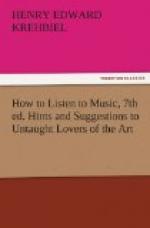A great deal of confusion has crept into the public mind concerning Wagner and his works by the failure to differentiate between his earlier and later creations. No injustice is done the composer by looking upon his “Flying Dutchman,” “Tannhaeuser,” and “Lohengrin” as operas. We find the dramatic element lifted into noble prominence in “Tannhaeuser,” and admirable freedom in the handling of the musical factors in “Lohengrin,” but they must, nevertheless, be listened to as one would listen to the operas of Weber, Marschner, or Meyerbeer. They are, in fact, much nearer to the conventional operatic type than to the works which came after them, and were called Musikdramen. “Music drama” is an awkward phrase, and I have taken the liberty of substituting “lyric drama” for it, and as such I shall designate “Tristan und Isolde,” “Die Meistersinger,” “Der Ring des Nibelungen,” and “Parsifal.” In these works Wagner exemplified his reformatory ideas and accomplished a regeneration of the lyric drama, as we found it embodied in principle in the Greek tragedy and the Dramma per musica of the Florentine scholars. Wagner’s starting-point is, that in the opera music had usurped a place which did not belong to it.[G] It was designed to be a means and had become an end. In the drama he found a combination of poetry, music, pantomime, and scenery, and he held that these factors ought to co-operate on a basis of mutual dependence, the inspiration of all being dramatic expression. Music, therefore, ought to be subordinate to the text in which the dramatic idea is expressed, and simply serve to raise it to a higher power by giving it greater emotional life. So, also, it ought to vivify pantomime and accompany the stage pictures. In order that it might do all this, it had to be relieved of the shackles of formalism; only thus could it move with the same freedom as the other elements consorted with it in the drama. Therefore, the distinctions between recitative and aria were abolished, and an “endless melody” took the place of both. An exalted form of speech is borne along on a flood of orchestral music, which, quite as much as song, action, and scenery concerns itself with the exposition of the drama. That it may do this the agencies, spiritual as well as material, which are instrumental in the development of the play, are identified with certain melodic phrases, out of which the musical fabric is woven. These phrases are the much mooted, much misunderstood “leading motives”—typical phrases I call them. Wagner has tried to make them reflect the character or nature of the agencies with which he has associated them, and therefore we find the giants in the Niblung tetralogy symbolized in heavy, slowly moving, cumbersome phrases; the dwarfs have two phrases, one suggesting their occupation as smiths, by its hammering rhythm, and the other their intellectual habits, by its suggestion of brooding contemplativeness. I cannot go through the catalogue of the typical phrases which enter into the musical structure of the works which I have called lyric dramas as contra-distinguished from operas. They should, of course, be known to the student of Wagner, for thereby will he be helped to understand the poet-composer’s purposes, but I would fain repeat the warning which I uttered twice in my “Studies in the Wagnerian Drama:”




